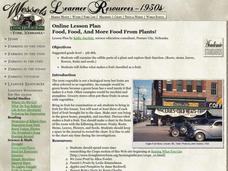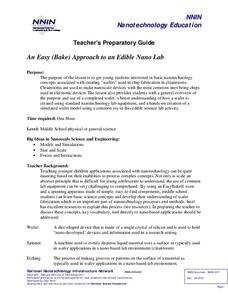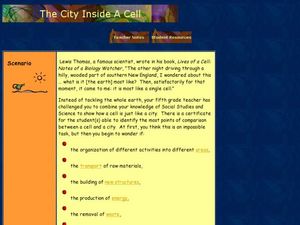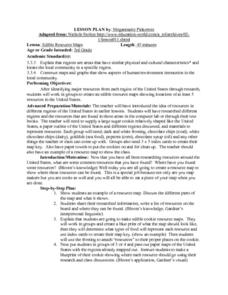Curated OER
Edible GMOs?
The debate over genetically modified organisms is on! Young biologists imagine that they have been asked to choose which corn chips will be sold for a fundraiser, one made with GMOs or one without. This four-day lesson plan requires...
Curated OER
We Eat Plant Parts
In this edible plants worksheet, learners study several elements to a root, leaf, fruit, and stem of a plant. Students complete several questions and draw the different elements.
Curated OER
Food, Food, And More Food From Plants!
Students examine the edible parts of a plant and explore their function. They define what makes a fruit classified as a fruit. They create a sketch or map or photo of a 1930s farm and justify their plant selections.
National Nanotechnology Infrastructure Network
An Easy (Bake) Approach to an Edible NanoLab
You can make it if you bake it! Young scientists model electronic chip fabrication with an easy bake oven. They create a design to embed in their brownie "chips" and compare their models to wafer production in basic nanotechnology.
Chymist
Earth Science
Explore the consistency of the earth's layers and soil through modeling. By conducting an engaging experiment, learners develop a model for the earth's layers and a soil profile using edible materials. Each material is chosen based on...
Curated OER
Eat Your Plants
Students explore fruits and vegetables. In this fruits and vegetables lesson, students work in small groups investigating plant parts. Students discover that fruits and vegetables originate from different parts of plants.
Curated OER
Plant Life for Kids
In these plant life worksheets, learners complete a worksheet about parts of a plant, plant life, plant life cycle sequence, and then complete a plant life mini book.
Curated OER
Fruit Flowers
Make a fun and healthy snack to celebrate Earth Day! Included are the directions for making a flower out of strawberries, kiwi, mint leaves, and raspberry licorice. Just provide your class with the materials and watch them make edible...
Curated OER
Making an Edible Coral Polyp
Students study anatomy. In this coral reef lesson, students recreate the anatomy of a coral polyp using edible materials. They work in pairs following step-by-step instructions given by the teacher. This lesson includes a list of...
Curated OER
Edible Plants
Students determine what part of a plant they are eating when they eat different fruits and vegetables, and make collages of fruit and vegetable pictures that are flowers, fruits, leaves, roots, seeds, seed pods, stems and tubers.
Curated OER
The Incredible, Edible Cell
Students discover organelles and the functions organelles perform in cells. In this biology lesson plan, students create model cells using Jell-o, then dissect their "cell" to examine the parts that create a cell. Students create a...
Curated OER
Parts of a Plant
Children explore the parts of a plant (flower, seeds, stem, leaves, and roots) using a dandelion as an example.
Curated OER
The City Inside a Cell
Students compare cell structure to the structure of a city. For this cell structure lesson, students investigate differences and similarities between cell structure and city structure. Students create a 3-dimensional, edible model of a...
Curated OER
Sheep Heart Dissection
Fifth graders examine a sheep heart. For this biology lesson, 5th graders dissect a sheep heart to identify the parts of a heart including the aorta, valve, septum, and ventricle.
Curated OER
Edible Plant Parts
Students participate in various activities to discover the six basic types of plants. In groups, they analzye the foods they eat and identify which part they consume. After reading "The Fablous Food Phantom", they create a food phantom...
Curated OER
Adjective Riddles
Students create a riddle using adjectives to describe an unknown edible substance to their classmates.
Curated OER
What's in That Cake?
Cooperative groups research trip logs from deep-sea expeditions and explore characteristics of deepwater habitats. Using a cake as the ocean floor, they work together to decorate it as a model of such habitats. They also prepare a...
Curated OER
From One Seed Grow Many Seeds
First graders practice identifying plants by singing a song. In this plant life lesson, 1st graders sing the song "Parts of a Plant" which is based on the anatomy of sunflowers. Students discover agriculture techniques while viewing a...
Curated OER
Edible Resource Maps
Third graders work in groups to create an edible resource map showing locations of at least five resources in the United States. Students research on the internet different regions and the resources that are found in those areas. They...
Curated OER
Edible Glacier
Students complete a KWL chart on what they know about glaciers. Then they gather together around a table containing Jello and Cool Whip cookie mixture and are introduced to the parts of a glacier by observing this model.
Curated OER
Writing an Explanation
Bananas are an important part of a healthy diet - but where do they come from? Third graders write an explanatory text about the origins of bananas. The bottom part of the paper includes necessary information about bananas, as well as a...
Calculated Industries
Army Survival
Intended as a reference tool for US Army personnel, this application can be used in a classroom that is studying historic and current wars or as part of an outdoor education or wilderness survival course. Some of the subjects addressed...
California Academy of Science
Exploring the Impacts of Feeding the World
Approximately 50 percent of people in the world who are chronically hungry work in agriculture. While it seems counter-intuitive, the farther you live from a farm, the more food options are available. Scholars explore concepts related to...
Curated OER
From Flower to Fruit
Students examine how flowers have essentially four parts. They learn both the male and female reproductive parts of the flower, then explore self-pollination and pollination by insects and other animals.
Other popular searches
- Human Body Parts Edible
- Sunflower Edible Parts
- Edible Parts of Plants
- Edible Parts of Fruits
- Edible Parts of Walnut
- Edible Parts of a Plant

























